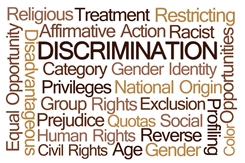Call Us At: 949-679-9909
Disparate Treatment and Impact Discrimination in Employment

The Differences Between Disparate Treatment And Disparate Impact In Employment Discrimination Cases
Both federal laws like Title VII of the Civil Rights Act of 1964 and California’s Fair Employment and Housing Act (FEHA) prohibit employers from discriminating against employees based on a number of characteristics, such as race, gender, religion, or national origin. California residents have even  more protections under the FEHA than federal laws because it protects more classes of individuals, applies to employers with as few as five employees, and offers better remedies to injured victims, such as no cap on the amount of compensatory damages for pain and suffering and punitive damages. However, under both federal laws and the Fair Employment and Housing Act, the employee claiming discrimination must show one of two types of discrimination: disparate treatment or disparate impact. What does this really mean?
more protections under the FEHA than federal laws because it protects more classes of individuals, applies to employers with as few as five employees, and offers better remedies to injured victims, such as no cap on the amount of compensatory damages for pain and suffering and punitive damages. However, under both federal laws and the Fair Employment and Housing Act, the employee claiming discrimination must show one of two types of discrimination: disparate treatment or disparate impact. What does this really mean?
What Is Disparate Treatment?
Disparate treatment means that an employer singled out a person or a group of employees and treated them differently than others based on a protected classification, such as race, gender, age, or sexual orientation. The focus in these cases is on how similarly situated comparable employees were treated and whether the employer’s decision was based on the victim’s protected status or another reason. Examples of this type of discrimination include:
- A person was denied a position or promotion based on race, and someone less qualified obtained the position or promotion.
- A person was humiliated and made to feel unsafe when co-workers or his supervisor made derogatory comments about people of color or women.
- A woman was pressured to engage in sexual activities to receive a raise, be promoted, or keep her job.
- An employee was threatened because of his sexual orientation.
- Rules were applied inconsistently to favor men over women.
In order to establish disparate treatment discrimination, the employee must establish a prima facie case that at least appears to show the actions were discriminatory. This is often shown through a four-part test that establishes the following:
- The employee is a member of a protected class under the law.
- The employee was qualified for the position, promotion, or other aspect of employment where he was discriminated against.
- The employee did not receive the job benefit he is complaining about.
- After the employee’s rejection, the job benefit remained open or was given to an employee not in the protected class.
What Is Disparate Impact Discrimination?
Disparate impact cases focus on the effects of the employer’s policy or practice rather than the employer’s intent. The policy or practice must have the effect of discriminating against a protected class of people even though it does not single them out for different treatment. The discrimination does not have to be intentional to be illegal. Examples of this type of discrimination include:
- A policy of terminating the highest paid employees could have the effect of discriminating against employees based on age.
- A requirement that workers are able to lift a certain weight when there is no lifting required for the job can result in discriminating against women and disabled people.
- A requirement that prospective employees pass a written test has the effect of eliminating most non-Caucasian people and has no relationship to the job.
The employee must present sufficient evidence that the employer’s neutral policy has a disproportionate effect on members of the protected class and is often shown through the use of statistics. These cases can be difficult to prove. Once the employee establishes a claim, the employer must refute it, often by attacking the statistical evidence or showing the policy is job-related and a business necessity. Even if the employer shows this, the employee can still win his case by proving that the employer refused to implement an alternative policy that has a less discriminatory effect on employees.
Were you discriminated against at your job? This is a very complex area of the law, and you will want to contact an experienced employment discrimination attorney to advise you on your rights under the federal and California laws that could protect you. Start an online chat or call us today at 949-570-6779 to schedule a free, no-obligation consultation.
Related Links:
No Legal fees unless you recover
The law offices of Corbett H. Williams takes most employee cases on a contingency fee basis
meaning that if we take your case, you pay nothing unless we recover for you.
Contact Us Today For a Free Case Evaluation Reliable & Trusted
If you are the victim of unlawful employment practices, including wrongful termination, sexual harassment, discrimination, or have not been paid all wages and benefits you are entitled to, the Law Offices of Corbett H. Williams can help. Call us today at 949-528-4220, or take a moment to fill out an online contact form for a prompt response. Delay could result in the loss of your claim, so don’t wait.
Request Your
Free Consultation
Fields Marked With An “ * ” Are Required

The Law Offices of Corbett H. Williams is always prepared to get clients started down the road to a more secure future. Take the first step and contact the firm today. The attorney will take care to answer questions and help decide what the most effective next step can be.

